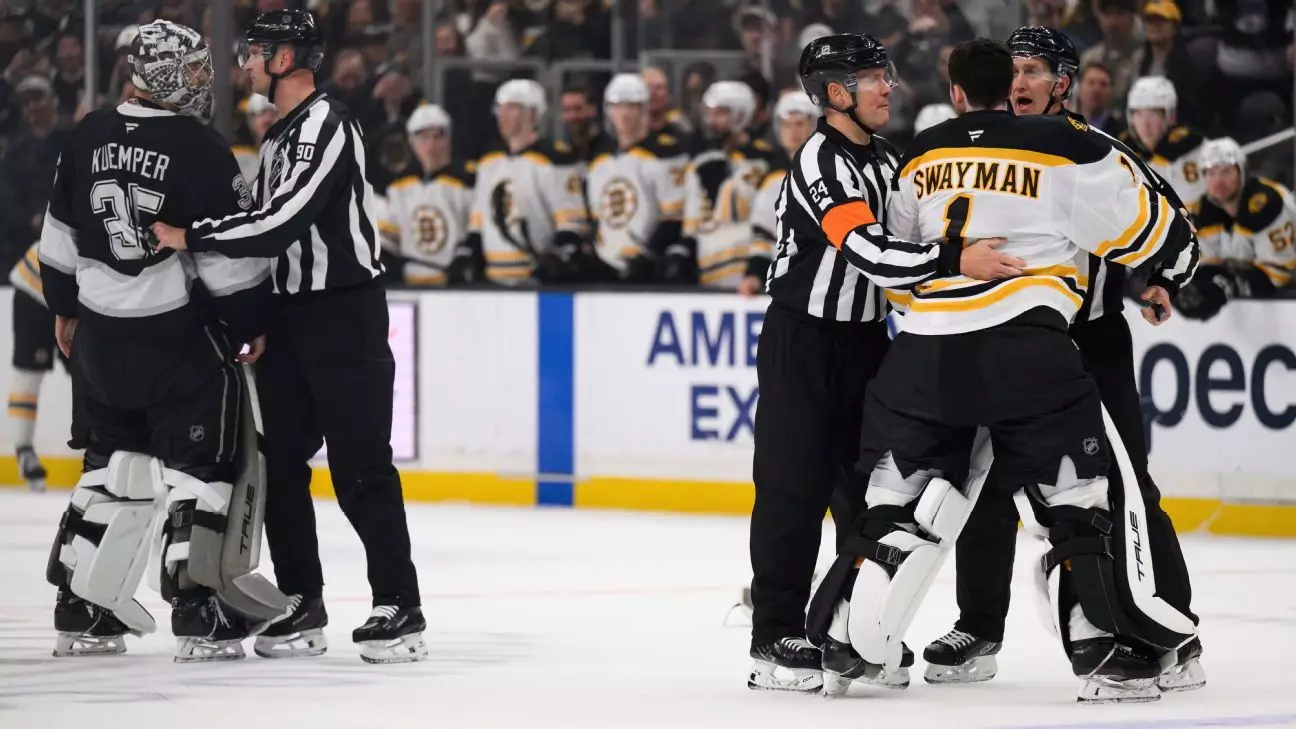Hockey is a sport defined by its intensity, speed, and, at times, its raw physicality. Rivalries run deep, and players often find themselves caught in heated exchanges that can lead to on-ice confrontations. These moments, while thrilling to fans, pose significant risks—not only to the players directly involved but to the teams as a whole. The recent near-brawl between goaltenders Darcy Kuemper of the Los Angeles Kings and Jeremy Swayman from the Boston Bruins exemplifies the thin line between passion and recklessness in the NHL. Since the heart-stopping days before the COVID-19 pandemic, goalie fights were all but extinct, yet the craving for these clashes still simmers beneath the surface.
The context behind these goaltender altercations is worth examining. The NHL has gradually shifted away from fights in favor of a more disciplined, strategy-driven style of play. Teams are realizing that losing key players to penalties—and potential injuries from fights—can jeopardize their season. In this light, the desire for a scrap must be weighed against the potential ramifications, particularly for goaltenders, who are indispensable in any playoff run.
The Kings’ Thriving Season and Kuemper’s Role
The Kings, boasting the best home record in the NHL, clearly understand this balance. With Darcy Kuemper standing tall in the crease, they’ve found a recipe for success. His performance has been nothing short of spectacular, with an impressive stretch of 14 consecutive home games without a regulation loss. Coach Jim Hiller’s reservations around Kuemper engaging in a brawl underscore the importance of safeguarding their star goaltender. Injuries could derail the Kings’ pursuit of the Cup, something absolutely inconceivable after their remarkable season.
Moreover, a goalie’s role is not just about defending against shots; it extends to maintaining composure under pressure. When emotions flare, as demonstrated in the Kuemper-Swayman incident, it’s vital that goalies reflect on their responsibilities. Reports show that goals yield high-stakes confrontations that can shift the momentum of the game, but involving themselves in physical altercations near-center ice is rarely productive. It undermines their position and disrupts their performance, and therein lies the irony: they risk losing the very thing they fight to protect.
The Fans’ Desire for Action
Despite the arguments against goaltender fights, fans often yearn for the spectacle of such showdowns. The excitement that envelops a potential brawl can electrify an arena, creating moments that transcend the typical ebb and flow of a game. When Kuemper and Swayman prepared to fight, the potential for chaos sent ripples through the crowd and social media. It’s this desire for entertainment that complicates the narrative. The thrill of a furor can entice fans, leading them to overlook the potential fallout of irrational behavior.
Yet, hockey culture has deemed these violence-filled standoffs as part of the tradition, leaving it up to players to decide how far they’re willing to go to uphold the sport’s gritty image. While it’s easy to romanticize the idea of goalies dropping their gloves, recent history tells a different story—these matchups can lead to unnecessary penalties and weigh heavy on a team’s ability to strategize effectively during crucial moments of the game.
Referees Stepping In: The Unsung Heroes
In recent years, referees have cultivated a reputation for keeping the peace and maintaining the game’s integrity. Tensions can boil over quickly, but the officials’ ability to gauge the intensity of a situation has made a difference in the manner in which conflicts unfold. The Kuemper and Swayman incident nearly evolved, but timely intervention ensured that neither goalie could jeopardize their team’s prospects or harm themselves. This invisible leadership is crucial for the sport, reminding all players that some lines shouldn’t be crossed.
Understanding the importance of this oversight is essential. As much as representational violence has been an embedded part of hockey, modernity calls for an elevation of respect, an understanding that a game shouldn’t devolve into a series of fisticuffs. The thrill of the chase surely remains, but growing awareness among players and coaches about the risks associated with fighting only reinforces the idea that there’s far more at stake in today’s game than mere bragging rights.
In the end, while fans pine for these moments of raw emotion, the broader implications underscore the reality that hockey transcends entertainment; it is about strategy, resilience, and, ultimately, respect for the game and its players.

